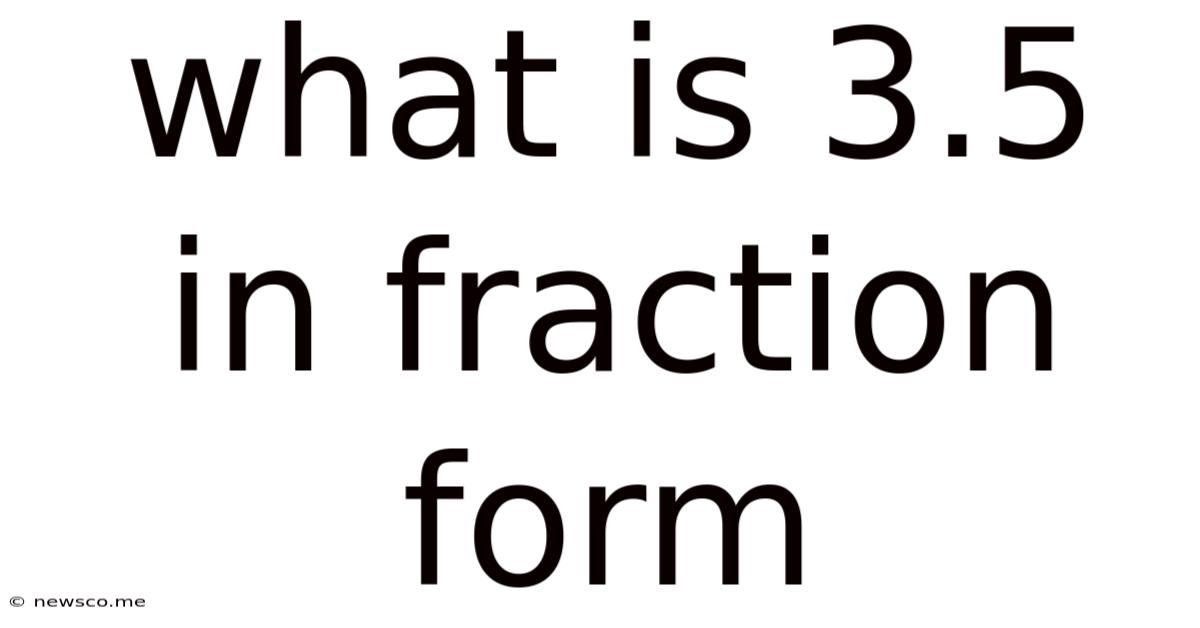What Is 3.5 In Fraction Form
News Co
Apr 04, 2025 · 4 min read

Table of Contents
What is 3.5 in Fraction Form? A Comprehensive Guide
Understanding how to convert decimals to fractions is a fundamental skill in mathematics. This comprehensive guide will walk you through the process of converting the decimal 3.5 into its fractional equivalent, explaining the steps involved and providing additional examples to solidify your understanding. We'll also explore the broader context of decimal-to-fraction conversion and delve into why this skill is important.
Understanding Decimals and Fractions
Before we dive into converting 3.5, let's briefly review the concepts of decimals and fractions.
-
Decimals: Decimals are a way of representing numbers that are not whole numbers. They use a decimal point to separate the whole number part from the fractional part. The digits to the right of the decimal point represent tenths, hundredths, thousandths, and so on.
-
Fractions: Fractions represent parts of a whole. They consist of a numerator (the top number) and a denominator (the bottom number). The numerator indicates how many parts you have, and the denominator indicates how many parts make up the whole.
The core principle behind converting decimals to fractions is recognizing the place value of each digit after the decimal point.
Converting 3.5 to a Fraction: A Step-by-Step Guide
The decimal 3.5 consists of a whole number part (3) and a fractional part (0.5). Here's how to convert it to a fraction:
Step 1: Identify the Fractional Part
The fractional part of 3.5 is 0.5. This represents five-tenths.
Step 2: Write the Fractional Part as a Fraction
We can write 0.5 as the fraction 5/10. The numerator (5) comes from the digit after the decimal point, and the denominator (10) is determined by the place value of that digit (tenths).
Step 3: Simplify the Fraction
The fraction 5/10 can be simplified by finding the greatest common divisor (GCD) of the numerator and denominator. The GCD of 5 and 10 is 5. Dividing both the numerator and denominator by 5, we get:
5/10 = 1/2
Step 4: Combine the Whole Number and the Fraction
Since the original decimal was 3.5, we need to combine the whole number part (3) with the simplified fraction (1/2). This gives us the mixed number:
3 1/2
Therefore, 3.5 in fraction form is 3 1/2. This can also be written as an improper fraction by converting the mixed number:
(3 x 2) + 1 / 2 = 7/2
Why is Converting Decimals to Fractions Important?
Understanding decimal-to-fraction conversion is crucial for several reasons:
-
Mathematical Problem Solving: Many mathematical problems require working with both fractions and decimals. Being able to convert between the two allows for flexibility in solving problems.
-
Real-World Applications: Fractions are frequently used in everyday life, from cooking and baking to measuring materials and understanding proportions. Converting decimals to fractions helps bridge the gap between theoretical math and practical applications.
-
Improved Number Sense: Converting decimals to fractions strengthens your understanding of number relationships and enhances your overall number sense.
-
Foundation for Advanced Math: A solid grasp of fraction and decimal concepts is foundational for more advanced mathematical topics, including algebra, calculus, and beyond.
Further Examples of Decimal to Fraction Conversion
Let's explore a few more examples to reinforce the concept:
Example 1: Converting 0.75 to a fraction
- Identify the fractional part: 0.75
- Write as a fraction: 75/100
- Simplify: Divide both numerator and denominator by 25 (the GCD): 3/4 Therefore, 0.75 = 3/4
Example 2: Converting 2.25 to a fraction
- Identify the fractional part: 0.25
- Write as a fraction: 25/100
- Simplify: Divide both by 25: 1/4
- Combine with the whole number: 2 1/4 or 9/4 Therefore, 2.25 = 2 1/4 or 9/4
Example 3: Converting 0.6 to a fraction
- Identify the fractional part: 0.6
- Write as a fraction: 6/10
- Simplify: Divide both by 2: 3/5 Therefore, 0.6 = 3/5
Example 4: Converting 1.375 to a fraction
- Identify the fractional part: 0.375
- Write as a fraction: 375/1000
- Simplify: Divide by 125: 3/8
- Combine with whole number: 1 3/8 or 11/8 Therefore, 1.375 = 1 3/8 or 11/8
Dealing with Repeating Decimals
Converting repeating decimals to fractions requires a slightly different approach. Let's consider an example:
Example: Converting 0.333... (0.3 repeating) to a fraction
This is represented as 0.3̅. Let's call this value 'x'.
- Set up an equation: x = 0.333...
- Multiply by 10: 10x = 3.333...
- Subtract the original equation: 10x - x = 3.333... - 0.333...
- Simplify: 9x = 3
- Solve for x: x = 3/9
- Simplify the fraction: x = 1/3
Therefore, 0.3̅ = 1/3
This method can be adapted for other repeating decimals, though the multiplication factor may need to change depending on the repeating pattern.
Conclusion
Converting decimals to fractions is a valuable skill with wide-ranging applications. By understanding the place value of digits in decimals and applying the principles of simplifying fractions, you can confidently convert any decimal to its fractional equivalent. This guide provides a solid foundation for tackling more complex decimal-to-fraction conversions and reinforces the importance of mastering this fundamental mathematical concept. Remember to practice regularly to solidify your understanding and build your confidence in handling numbers efficiently.
Latest Posts
Related Post
Thank you for visiting our website which covers about What Is 3.5 In Fraction Form . We hope the information provided has been useful to you. Feel free to contact us if you have any questions or need further assistance. See you next time and don't miss to bookmark.